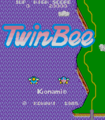Notmyhandle (talk | contribs) (removed duplicate cats, Image->File) |
Notmyhandle (talk | contribs) (cleanup, additional release info from Wikipedia, 3D classics title screen) |
||
| Line 5: | Line 5: | ||
|developer=[[Konami]] | |developer=[[Konami]] | ||
|publisher=[[Konami]] | |publisher=[[Konami]] | ||
|distributor=[[Wii | |distributor={{sys|wiivc|top=1}}[[Wii Shop Channel]]{{sys|3ds|wiiuvc}}[[Nintendo eShop]] | ||
|japanese=ツインビー | |japanese=ツインビー | ||
|genre=[[Shooter]] | |genre=[[Shooter]] | ||
|systems=[[Arcade]], [[NES]], [[Family Computer Disk System]], [[MSX]], [[Sharp X68000]], [[Mobile]], [[Game Boy Advance]], [[PlayStation Portable]], [[Nintendo DS]], [[Nintendo 3DS]], [[Wii]], [[Xbox Live Arcade]] | |systems=[[Arcade]], [[NES]], [[Family Computer Disk System]], [[MSX]], [[Sharp X68000]], [[Mobile]], [[Game Boy Advance]], [[PlayStation Portable]], [[Nintendo DS]], [[Nintendo 3DS]], [[Wii]], [[Xbox Live Arcade]] | ||
|released={{collapsible list|title=1985–2011|{{sys|arcade}}{{jp|1985|March 5}} | |released={{collapsible list|title=1985–2011| | ||
{{sys|arcade}}{{jp|1985|March 5}} | |||
{{sys|nes}}{{jp|1986|January 4}} | {{sys|nes}}{{jp|1986|January 4}} | ||
{{sys|msx}}{{jp|1986|May 25}} | {{sys|msx}}{{jp|1986|May 25}} | ||
{{sys|X68000}}{{jp|1988|February}} | |||
{{sys|fds}}{{jp|1988|March 11}} | {{sys|fds}}{{jp|1988|March 11}} | ||
{{sys|mobile}}{{jp| | {{sys|mobile}} | ||
;i-mode and Vodafone (TwinBee Deluxe Edition) | |||
{{jp|2003}} | |||
{{sys|gba}}{{jp|2004|May 21}} | {{sys|gba}}{{jp|2004|May 21}} | ||
{{sys| | {{sys|wiivc}} | ||
{{sys| | ;Famicom version | ||
{{sys|3ds}}{{jp|2011|August 10}}{{us|2011|September 22}}{{eu|2011|September 22}}{{au|2011|September 22}}}} | {{jp|2008|August 5}} | ||
{{sys|360|win}} | |||
;Game Room | |||
{{rd|2010|November 5}} | |||
{{sys|3ds}}{{jp|2011|August 10}}{{us|2011|September 22}}{{eu|2011|September 22}}{{au|2011|September 22}} | |||
{{sys|wiiuvc}} | |||
;Famicom version | |||
{{jp|2013|September 4}} | |||
;MSX version | |||
{{jp|2015|March 18}} | |||
{{sys|win}} | |||
;EGG Project | |||
{{jp|2014|August 19}} | |||
}} | |||
|players=1-2 co-operative | |players=1-2 co-operative | ||
|followed by=[[Stinger]] | |followed by=[[Stinger]] | ||
| Line 35: | Line 52: | ||
File:Twinbee title.png|Title screen | File:Twinbee title.png|Title screen | ||
File:Twinbee Flyer.jpg|Famicom flyer | File:Twinbee Flyer.jpg|Famicom flyer | ||
File:Twinbee 3D Classics title screen.jpg|3D Classics title screen. | |||
</gallery> | </gallery> | ||
| Line 61: | Line 79: | ||
[[Category:3D Classics]] | [[Category:3D Classics]] | ||
[[Category:Game Room]] | |||
[[Category:MAME]] | [[Category:MAME]] | ||
[[Category: | [[Category:Multiplayer]] | ||
[[Category:Nintendo eShop]] | |||
[[Category:Project EGG]] | |||
[[Category:Shooter]] | [[Category:Shooter]] | ||
[[Category:Single player]] | [[Category:Single player]] | ||
[[Category:Co-op]] | [[Category:Co-op]] | ||
[[Category:Konami]] | [[Category:Konami]] | ||
Revision as of 00:41, 23 April 2015
Template:Infobox Template:Series disambig
TwinBee is an arcade game developed by Konami and released on March 5, 1985. Each player controls two jet fighters who must progress through each stage defeating a variety of strange and unusual enemies. Much like the Parodius series that the TwinBee fighters have been featured in, TwinBee lampoons the scrolling shooter genre, taking elements that are found in games like Xevious and adding humor to them.
In TwinBee, two players can play simultaneously. One or two players glide along vertically scrolling stages in an effort to reach the boss and defeat it. They can shoot up into the air, and lob bombs at the ground, but only if at least one of the ship's arms are still functional. Along the way, different kinds of power ups can be collected. The most common one are the bells which must be shot out from inside clouds. The bells are bounced back into the sky by getting shot. Occasionally, a shot will change their color from the ordinary yellow. If they are picked up then, they grant the player with different power-ups depending on the color.
When two people play together, they can access partnership weapons that are only available to them in a two player game. TwinBee became rather popular in Japan, but not so much in the United States. This one game lead to several direct sequels, as well as a number of spin-off games. The game was converted for play to a number of popular Japanese systems, such as the Famicom, MSX, and a near perfect translation on the Sharp X68000. It later saw a rerelease on the Game Boy Advance, and was contained a many Konami classic compilations.
-
Title screen
-
Famicom flyer
-
3D Classics title screen.
Story
In the space calendar year 2801, the peaceful Donburi Island was suddenly attacked. The attack was carried out by an army led by the Spice King.
When the Spice King occupied the island, he stole five precious articles from the inhabitants and divided them up among his four generals. The island was then divided into five parts and ruled.
Meanwhile, the curious scientist Dr. Cinnamon, who lived at the end of the island, was secretly developing two sets of fighter planes, "TwinBee" and "WinBee." Dr. Cinnamon's pupils Annamon and Donnamon volunteered to pilot the planes and bravely challenged the enemy.
Table of Contents
Gameplay summary
- Each player pilots either the blue TwinBee ship or the pink WinBee ship.
- Each player can shoot upwards, or lob bombs at the ground, but only if at least one arm is remaining.
- If a player is shot by a bullet, and an arm is present on the side that they were hit, they lose the arm.
- Losing both arms will not kill the player, but getting hit again on either side will.
- Colliding into an enemy will cause the player to lose one life.
- If shots are fired into a cloud, a bell may appear. Shooting the bell causes it to bounce, and it may change color.
- Collected the bells when they are different colors grants different power ups.
- Collecting consecutive yellow bells without missing one will result in an increasing number of bonus points.


